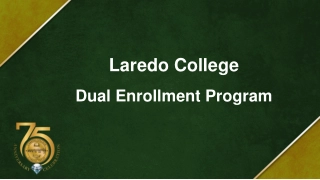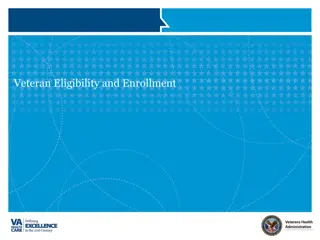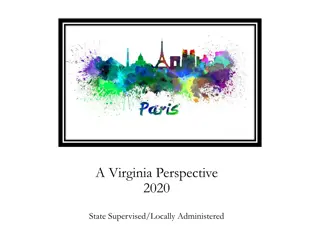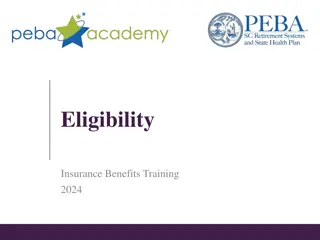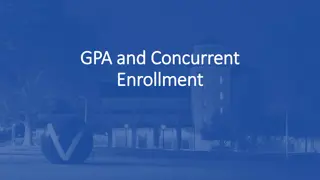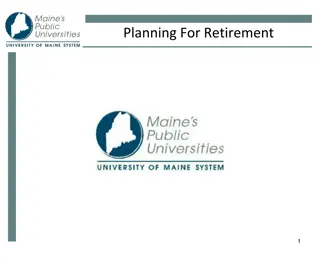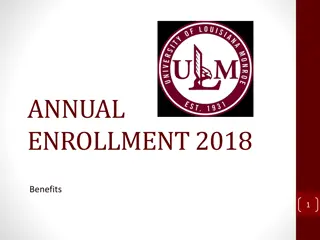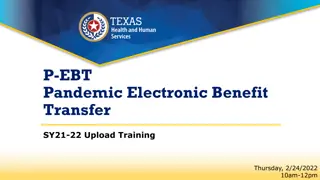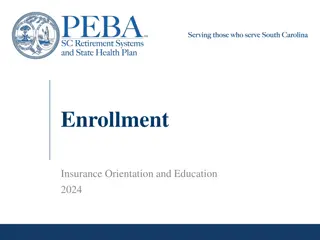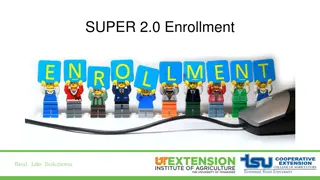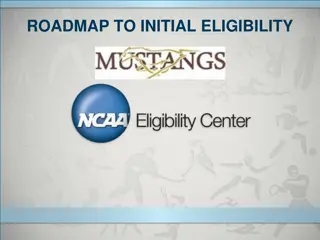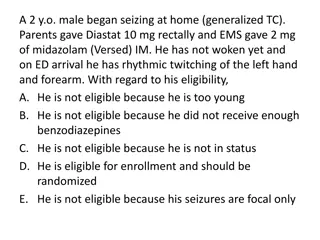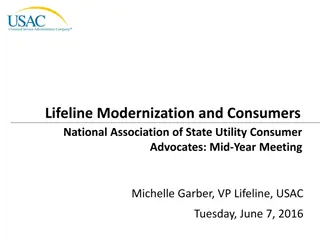Understanding Head Start Enrollment and Eligibility Criteria
This report discusses the enrollment and eligibility criteria of the Head Start program, which was established in 1965 to provide early childhood education to children from low-income families. The criteria for eligibility, enrollment statistics, characteristics of Head Start children, and the significance of quality data on Head Start are highlighted. The program's impact and reach over the years are examined, emphasizing the importance of addressing unequal access to early childhood education.
- Head Start program
- Early childhood education
- Low-income families
- Enrollment criteria
- Childhood development
Download Presentation

Please find below an Image/Link to download the presentation.
The content on the website is provided AS IS for your information and personal use only. It may not be sold, licensed, or shared on other websites without obtaining consent from the author. Download presentation by click this link. If you encounter any issues during the download, it is possible that the publisher has removed the file from their server.
E N D
Presentation Transcript
Whos in Head Start? Estimating Head Start Enrollment with the ACS, CPS, and SIPP Lynda Laughlin and Jessica Davis U.S. Census Bureau Annual Meeting of the Population Association of America, Washington, D.C., March 31-April 2, 2011 This report is released to inform interested parties of research and to encourage discussion. The views expressed on statistical, methodological, technical, operational and any other issues are those of the authors and not necessarily those of the U.S. Census Bureau.
Head Start To address the unequal access to early childhood education programs, the federal government established Head Start in 1965 to serve preschool children from low-income families. In 1965, the program served 561,000 children at the cost of $96 million. As of 2007, the Head Start program disbursed $6.9 billion in funds and served 908,412 low-income children. Given the considerable federal investment in Head Start and the importance of child care for child development and maternal employment, high quality data on Head Start is vital.
Criteria for Head Start Eligibility Not all children are eligible to participate in Head Start programs. The primary criteria used for eligibility are the following: A family income below the Federal Poverty Line The receipt of some form of public assistance, including receipt Supplemental Security Income (SSI), Temporary Assistance for Needy Families (TANF) program and Food Stamps. Ten percent of enrollment opportunities are available to children with disabilities.
Table 1. Head Start Administrative Data : 2005 Characteristic HS Admin % Total 906,993* 100% MARITAL STATUS OF MOTHER Married 380,937 42% Single mother 526,056 58% RACE & HISPANIC ORIGIN OF MOTHER White alone 317,448 35% Black alone 282,075 31% Asian alone 17,233 2% Hispanic (of any race) 298,401 33% AGE Under 3 90,699 10% 3 years old 308,378 34% 4 years old 471,636 52% 5 years old 36,280 4% *Includes total number of children enrolled in Head Start for all 50 states , the District of Columbia, American Indian programs, migrant programs, and six territories. Source: Head Start Administrative Data 2005
Characteristics of Head Start Children Head Start serves a diverse group of children and families from primarily low-income families. Eighty-six percent of children in Head Start are three or four years old (Table 1). In 2005, 35% were white, 31% were black, and 33% were Hispanic. Head Start students tend to fall into two age groups: 52% were 4 years old and 35% were 3 years old. Most head start students, 58%, live with a single parent. More than half of students come from families who are unemployed or work part time or seasonally.
Head Start families are generally very poor. Eighty-eight percent of Head Start children lived in households with incomes below the federal poverty level. Seven percent of children were enrolled in Head Start although their families were over-income (PIR 2005). Twenty percent of Head Start families received TANF (welfare) benefits (PIR 2005). Nearly nine in 10 Head Start programs are operated through a center-based program. A much smaller number of programs were operated via family-day care homes (CLASP Brief, 2006). Over 24,000 children served by Head Start in 2005 were in families classified as homeless (PIR 2005).
Survey Data Survey data often undercounts Head Start enrollment which presents a challenge to researchers and policy makers who are trying to better understand the needs of low-income families. Parents may not know if their child is enrolled in a Head Start program, especially if the program does not explicitly use Head Start in it s title. Parents may also not consider Head Start, which is often located within school buildings, a child care arrangement. Money for Head Start flows through centers and not people.
The design and implementation of the Census Bureaus Survey of Income and Program Participation (SIPP) child care module may lead to a certain amount of age shifting. In this study we consider if it is possible to indirectly estimate the number of children enrolled in Head Start using other Census Surveys, such as the Current Population Survey (CPS), the American Community Survey (ACS), and the Survey of Income and Program Participation (SIPP).
Criteria used to produce Head Start Estimates Head Start Administrative Data Limited to children 3 and 4 years old Limited to the 50 states and the District of Columbia to match ACS, CPS, and SIPP sampling frames. Based on the criteria listed above, 780,014 children 3 and 4 were enrolled in Head Start in 2005 for all 50 states and the District of Columbia. Criteria used to estimate enrollment from ACS and CPS Children ages 3 and 4 years old Children in families with an income below poverty Proxy measure used for CPS Additional measure for Public Assistance used for ACS estimates to produce a alternative estimate measure Enrolled in nursery school or preschool
Criteria used to estimate enrollment from SIPP Enrolled in Head Start Children ages 3 and 4 years old Children in families with an income below poverty, or receive a subsidy, or welfare and in a day care center or nursery school. In addition to the criteria listed above, our SIPP estimates will also try to account with undercount of Head Start children related to age shifting Besharov et al. (2006) suggest that age shifting distorts the child care arrangements of children under 6 because child care is highly seasonal. Age shifting may lead to an undercount of Head Start children. To account for age shifting we apply the criteria listed above by also including 5 years olds.
Figure 1. Estimated Head Start Enrollment, 2005 CPS (age = 3 or 4, in poverty, enrolled in nursery/preschool) 1,200,000 1,039,518 1,000,000 780,014 800,000 573,652 600,000 471,636 465,866 400,000 308,866 200,000 - Number All 3 year olds 4 year olds CPS Head Start Admin Source: U.S. Census Bureau, CPS 2005 and Head Start Administrative Data, 2005
The October CPS lacks a reliable poverty measure and over predicts estimated enrollment by more than 259,000 children. We suspect that the lack of a reliable poverty measure contributes to such a large over count. Due to the importance of poverty as a eligibility factor for Head Start, we believe that it is not recommended to use CPS to estimate Head Start enrollment.
Figure 2. Estimated Head Start Enrollment, 2005 ACS (age = 3 or 4, in poverty, enrolled in nursery/preschool) 900,000 780,014 800,000 700,000 580,489 600,000 471,636 500,000 394,277 400,000 308,866 300,000 186,212 200,000 100,000 - Number All 3 year olds 4 year olds ACS Head Start Admin Source: U.S. Census Bureau, ACS 2005 and Head Start Administrative Data, 2005
Controlling for poverty, we estimated 580,489 three and four year olds enrolled compared to the official Head Start count of 780,014. At the state level, ACS generally undercounted Head Start enrollment. Compared to administrative data, estimates provided for 25 states were statistically different by at least 4.9 percent or lower. Estimates for 16 states were statistically different by at least 5 percent or more. ACS estimates over-counted enrollment for New Jersey and North Carolina, but the difference between the ACS estimate and administrative data was only statistically different for North Carolina.
Figure 4. Estimated Head Start Enrollment, SIPP 2005 900,000 780,014 780,014 780,014 800,000 701,000 700,000 600,000 542,000 500,000 400,000 300,000 201,000 200,000 100,000 - Number Original SIPP* 3-4 year old 3-5 year olds SIPP Head Start Admin Original SIPP estimate based on children 3 and 4. Source: SIPP 2004, Wave 5. For information on sampling and nonsampling error see <www.census.gov/sipp/sourceac/S&A04 W1toW12(S&A-9).pdf>
Figure 5. Comparison of SIPP, Estimated SIPP, and Administrative Head Start Data by Race and Hispanic Origin 70 58 58 58 60 50 38 40 35 34 33 33 31 30 22 20 19 20 10 0 White alone Original SIPP* Black alone Hispanic Percent SIPP 3-4 SIPP 3-5 Head Start Admin Original SIPP estimate based on children 3 and 4. Source: SIPP 2004, Wave 5. For information on sampling and nonsampling error see <www.census.gov/sipp/sourceac/S&A04 W1toW12(S&A-9).pdf>
Figure 6. Comparison of SIPP, Estimated SIPP, and Administrative Head Start Data by Poverty Status 100 88 90 80 70 59 60 54 52 46 50 44 40 40 30 20 7 10 0 Percent Below Poverty Original SIPP* At or Above Poverty Head Start Admin SIPP 3-4 SIPP 3-5 Original SIPP estimate based on children 3 and 4. Source: SIPP 2004, Wave 5. For information on sampling and nonsampling error see <www.census.gov/sipp/sourceac/S&A04 W1toW12(S&A-9).pdf>
Our initial model improves upon the original SIPP Head Start estimates of 3 and 4 year olds by 341,000 children. Yet, our estimates still falls short of the official Head Start enrollment of 780,014 children. By including 5 year olds, our SIPP estimate of 701,000 comes the closest to the official count. The estimated SIPP 3 to 4 year old Head Start population statistically differs from the official characteristics of Head Start children for the following: A higher proportion of children are white (58 % vs. 35%) A lower proportion of children are Hispanic(20% vs. 33%) A lower proportion of children are below poverty (52 % vs. 75%)
Summary Suggesting that limiting our sample to children and families who are eligible for Head Start by poverty alone does not mirror the official count of Head Start children. By controlling for income and other characteristics common to Head Start families we were able to close the gap between our estimated values and administrative data. CPS Due to the importance of poverty in determining Head Start eligibility, we do not suggest using the October CPS to estimate Head Start enrollment. ACS ACS estimates undercounts Head Start enrollment at the national level. At the state level, ACS estimates are general lower than administrative data and varies across the states in no discernable pattern.
SIPP By controlling for poverty, child subsidy receipt, and welfare usage, we were able to improve upon the original SIPP Head Start estimates for 3 and 4 year olds. If we account for age shifting and include 5 year olds, our estimated Head Start enrollment improves substantially, yet the SIPP data fails to mirror the social and economic characteristics of Head Start children. Of the three surveys examined in this study, SIPP provided the closest estimates but can not provide information at the state level, which may be of more interest to policy makers.
Discussion and Future Steps This study illustrates that there are several methodological and conceptual challenges in measuring Head Start enrollment. It is difficult to correctly identify Head Start families. Families are often unaware of, or misunderstand, the eligibility guidelines. Sampling variability could cause estimates to vary. The sampling frame for SIPP, CPS, and ACS is the civilian noninstitutionalized population living in the United States. Therefore, homeless children in Head Start would not be sampled.
A series of questions regarding Head Start enrollment, instead of a single question, could improve estimates. Currently testing revised questions regarding Head Start on the redesigned SIPP. We may never get a full picture of Head Start usage from household surveys. Head Start funds are administered to grantees, not states. Each grantee may vary in their administration of the program to meet the needs of their immediate community.
Contact Information Lynda Laughlin Fertility and Family Statistics Branch Lynda.L.Laughlin@Census.Gov Jessica Davis Education & Social Stratification Branch Jessica.W.Davis@Census.Gov


